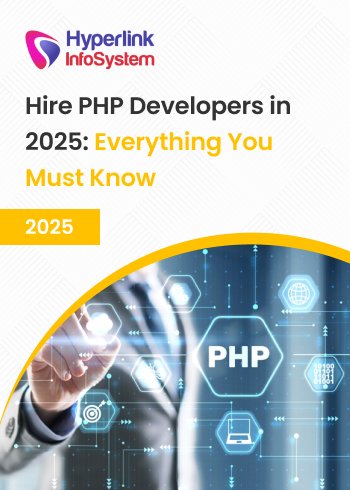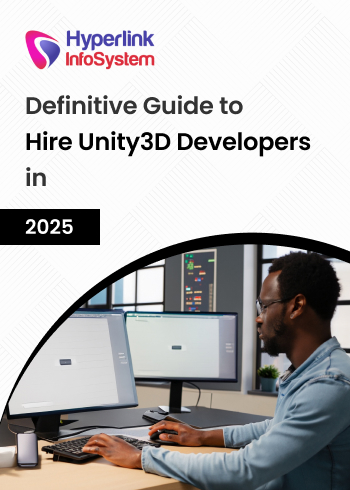The COVID-19 pandemic presented a much-needed sanity check for IoT-inspired structures and solutions. IoT solutions such as exclusive health monitoring and contact tracing rendering support for authorities to control the coronavirus spread successfully.
The theory of the Internet of things, or as we call it, IoT, has driven our lives by a blow over the past few years. The only physical devices or things that you could connect to the Internet were your PC or laptop and your smartphone in the past. Nevertheless, with the arrival of IoT, various devices in the comparable home, including numerous household devices, can now be connected to the Internet.
Given that it is a new technology and has already commenced exercising over considerable chunks of our lives, IoT’s future scope resembles to be bright and diverse. An aging community, a growing population, costly medical assistance, and outdated Healthcare infrastructure have all increased the demand for IoT.
This article produces the first comprehensive review of critical
IoT solutions that have affected
COVID-19 in Healthcare, connection tracing, and transport during the pandemic. Each division is investigated in-depth, and also the inherent applications, social and economic impact, and mass evolution barriers are discussed.
The below-mentioned description will provide an in-depth summary and categorization of sector-wise IoT technologies, which can be pre-eminent applications in the new normal. IoT applications in each chosen sector are rated for their potential economic and social influence, the timeline for mass conversion, and Technology Readiness Level (TRL).
In addition, this article describes potential research directions for next-generation
IoT apps that would facilitate enhanced performance with preserved privacy and security and more comprehensive adaptation by the population at large.
What Is IoT, And How Does IoT Work?
First of all, let us understand what exactly IoT is and how it works. IoT stands for The Internet of Things. IoT is also referred to as the Internet of Everything (IoE) in other words. In manageable terms, the IoT can be explained as a network of interconnected devices.
The IoT consists not of separate tools but an entire ecosystem of interconnected devices. These devices are equipped with multiple sensors and processors that concede information from encompassing circumstances and are sent over the network.
The Internet of Things uses numerous illustrations - from intelligent thermostats and bulbs to car trackers and even health monitors.
The method can also automatically execute inevitable claims based on predefined user inclinations with no social communication. The following option is called the machine-to-machine (M2M) interface.
The subsequent action of their development is an invasion of other businesses, including healthcare.
IoT in the healthcare industry has more potential all over the world than in any other sector. The merger of IoT and healthcare will be immersed in the Healthcare infrastructure.
Recently, the healthcare sector has shown brisk growth and has been a significant contributor to revenue and employment. A few years ago, the human body's analysis of diseases and abnormalities was only possible after having a physical examination in the hospital.
Most patients have to linger in the hospital throughout their treatment period. This situation results in extended Healthcare costs and wrenches the Healthcare facility in rural and remote locations.
The technological progress achieved through these years has now conceded many diseases and health monitoring utilizing miniaturized devices like smartwatches.
Moreover, technology has transformed a hospital-centric healthcare system into a patient-centric approach. For example, many clinical examinations, such as measuring blood pressure, blood glucose level, pO2 level, level, etc., can be monitored at home without any help from a healthcare expert.
Further, the clinical data can be given to Healthcare centers from remote areas with the help of high-level telecommunication services. The use of such communication services in connection with rapidly growing technologies (e.g., machine learning, extensive data analysis, Internet of things (IoT), wireless sensing, mobile computing, and cloud computing) has developed the accessibility of Healthcare facilities.
IoT has enhanced independence and diversified the ability of humans to interact with the external environment. IoT, with the help of futuristic protocols and algorithms, became a significant contributor to global communication. It connects many tools, wireless sensors,
smart home appliances, and electronic devices to the Internet.
A study done by Statista proves that the installation of more than 160 million healthcare IoT devices was seen by the year 2020. When people address the exponential growth of IoT lately and in the near future, it isn't an exaggeration: the global business for IoT is expected to grow by 2025. In other words, IoT is here to stay, and it will be indispensable in the future.
The IoT applications can be found in agriculture, automobiles, home, and Healthcare. The growing demand for the IoT is due to its success in showing higher accuracy, lower cost, and predicting future events.
The IoMT(Internet of Medical Things) has streamlined methods and enhanced the patient experience. IoT technology has unquestionably improved Healthcare, beginning with the before-mentioned revolutionary discoveries such as glucose monitoring, depression, and mood monitoring, Parkinson's condition monitoring, correlated inhalers, contact lenses, automated insulin delivery, and more.
Patients benefit from assistance, more robust engagement, and more infrequent in-person medical appointments. Providers have obtained added accurate data, more trustworthy diagnoses, and more productive time management.
Further, expanded
knowledge of embedded software and applications, the up-gradation of mobile and computer technologies, easy accessibility of wireless technology, and the enhanced digital economy have added to the rapid IoT revolution. The IoT devices (sensors, actuators, etc.) have been integrated with other dynamic devices to control and exchange information using various wireless communication protocols such as Bluetooth, Zigbee, Wi-Fi, etc.
Aiming to maximize the employability of IoT in Healthcare practices, many countries have embraced new technology and policies. This acceptance molded the current research in the healthcare sector into a more advantageous field to explore.
In the future, IoT can make the healthcare industry more efficient, accurate, and cheaper. It can also help in developing more patient-oriented and customized equipment. Moreover, IoT will also help patients to have hassle-free visits to hospitals, easy treatments, and access to more and more information. It will also help people to get better access to data and to give personalized care, and as a result, patients will have fewer visits to the hospitals.
The IoT framework utilized for Healthcare applications aids in integrating the advantages of IoT technology and cloud computing with the field of medicine. It also lays out the treaties for transmitting the patient's data from numerous sensors and medical devices to a given Healthcare network.
The topology of an IoT is the adaptation of different components of an IoT Healthcare system or network that connects the Healthcare environment coherently. A basic IoT system contains three elements: publisher, broker, and subscriber.
A system of wirelessly correlated physical devices that exchange data has changed the healthcare industry is known as IoT — and it shows no signs of stopping.
Healthcare IoT, also associated with the Internet of Medical Things (IoMT), has enabled remote patient care, advanced hospital and pharmaceutical procedures, and enhanced data accuracy. The hospital hygiene monitoring tools help prevent patient infections, whereas IoT devices in hospitals aid in controlling refrigerator temperatures, expediting emergency care, and things of that nature.
Outside of medical amenities, patients wear heart rate informants, blood pressure monitoring bands, and glucose monitoring mechanisms give a few examples that feed results to their doctors.
These technological progressions have been unique, and it is developing very aggressively.
The chances for other
IoT development swarms currently as already, it is expanding in the applications areas of emergency care, insurance practices, and pharmacies.
As explained above, an IoT unit can be acknowledged as a device with a sensor that can communicate with the natural world and send information to the Internet.
In the healthcare industry, these tools can assemble various patient data and obtain information from health practitioners. An IoT in Healthcare example is constant glucose monitoring for insulin pens that operate efficiently for patients with diabetes.
All these devices can interact with each other and take necessary procedures that would provide convenient aid or even save a life. For instance, IoT Healthcare equipment can execute rational judgments like connecting with the emergency care unit while collecting patient data in the case of an emergency. Along with that, it can also send general patient data to the concerned person, such as doctors, emergency contact persons, and many more. After accumulating passive data, the IoT Healthcare device would convey this crucial message to the cloud so that doctors can work on it — observe the general patient status, see if requesting an ambulance is inevitable, what sort of remedy is needed, and so on.
Thus, the Internet of Things in Healthcare can significantly increase a patient’s well-being and aid in dangerous circumstances and the productivity of health representatives and hospital workflows.
Let's learn how the approach has been so far in each considered area and the possibilities for continued progression.
Emergency Medical Attention:
IoT advances have significantly reduced emergency room wait times. Radio Frequency Identification (RFID) tags, infrared sensors, and computer vision accumulate real-time data about hospital bed availability. This revolution helps identify patients who no longer need emergency rooms and move them from emergency to observation rooms. However, this makes it easy to make space for those who need admission urgently.
The same data also assists Emergency Medication Technicians (EMTs) who bring patients to hospitals. If EMTs comprehend that one hospital lacks patient beds, they can reroute to another hospital with capacity.
In addition to assisting in bed availability, infrared sensors trace the blood supply and samples available at the hospital. This data also aids EMTs in acknowledging the best facility to take a patient to.
Upon entering a crisis room and enrolling, patients receive IoT-enabled ID wristbands that trace them through each step of their visit. This assists facilities in analyzing how long patients spend in each part of the method to uncover areas in need of healing.
The prospect of emergency medical care could include similar technology in the form of an IoT- enabled badge that controls blood pressure, pulse, body temperature, and respiratory rate. If a patient abruptly spikes a fever while expecting to be seen, the badge will send a sign to notify the medical team.
The Below-mentioned Factors Are Driving The Rapid Growth Of The IoT Market
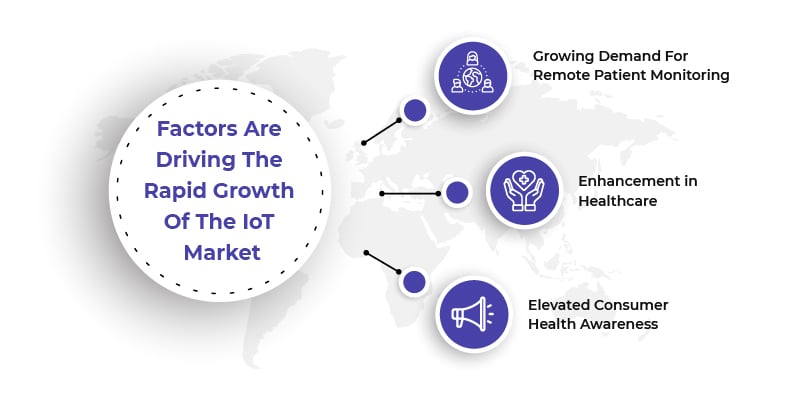
1. Growing Demand For Remote Patient Monitoring
Not all medical conditions demand an in-person visit, and along with that, some medical conditions, such as Asthma, heart attacks, and many more, demand on-time action. Remote patient monitoring and care can do wonders over here. The IoMT devices will collect and save the medical reports and conditions to the mobile application that can help the doctors or an available person to take the appropriate actions on time. Along with that, it will help doctors to consult patients in an accurate manner without connecting and communicating in the real world.
2. Enhancement In Healthcare
According to
Data Bridge Market Research, the IoMT market is growing with a CAGR of 22.2% in the forecast period of 2021 to 2028 and is expected to reach USD 49,889.21 million by 2028. Various factors such as getting accurate patient data, reducing the need for personal checkups, giving affordable means of continuous health monitoring, and basically building hospitals without walls are making it happen. IoMT is making the world conscious of their health by offering tons of devices that can help them generate custom data and offer an accurate solution to take better care of their health.
3. Elevated Consumer Health Awareness
While exposing the shortfalls of the Healthcare systems, the COVID-19 pandemic also brought awareness about one's health, enhanced usage of masks to enhanced usage of smart devices to track and monitor vitals, including body temperature and heartbeat, cholesterol levels, and sleep patterns, to name a few have made the world health conscience. Along with this, the usage of IoMT devices is making people around the world aware and more conscious about the importance of mental health, accurate sleep cycle, fitness, and more by generating and delivering accurate medical data.
If you think there are just a few IoT medical devices that exist, then we are going to burst the bubble. Let’s explore types of IoT medical tools.
According to the World Health Organization, there are approximately 2 million different kinds of medical instruments on the world market, categorized into more than 7000 generic media groups.”
The technology is developing customized software and devices that read the data from the medical cards of patients in real-time and help doctors to generate a better analysis of patients’ health. These devices come in different styles and sizes: from home monitoring tools to insulin pumps to pulse oximeters. All of these solutions come into the following groups:
1) Point of Care Devices
Point of care devices are a wide array of diagnostic tools intended to produce results outside of laboratory environments. They are commonly used at the doctor's office or at home to assemble and analyze examples such as blood, saliva, skin cells, etc.
2) Smart Pills
Smart Pills, also identified as intelligent drugs or digital pills, are small electronic devices in pharmaceutical capsules carrying ingestible sensors. Such smart pills perform multiple functions, such as monitoring important well-being indicators (local pH, temperature, blood pressure), giving drugs to a targeted area, imaging for effective diagnosis of gastrointestinal disorders, etc.
3) Emergency Response Systems
Personal emergency response operations, sometimes known as medical alert methods, are special medical devices used to request help when an emergency event occurs via a help button. PERSs can be effective for those limited in their mobility and require emergency medical care, the elderly, for example.
4) Clinical-Scale Wearables
Clinical-scale wearables are the IoT tools and supporting platforms certified and recommended by respective regulatory and health authorities, such as the FDA (US Food and Drug Administration). Devices in this category are commonly used at home or in clinics prescribed or advised by a physician. Their focus is essential to improve chronic conditions and diseases.
5) Consumer Scale Wearables
Consumer-scale wearables are different kinds of wearables for tracing critical indicators of personal wellness or fitness. They carry built-in sensors that accumulate and maintain the data every time a user does physical activities. These devices continually inform patients about their daily physical activities. Now they can even track the oxygen Level of a person very accurately. Moreover, they can also help in preventing emergencies, as patients' information would be sent to their respective doctors or family members immediately.
6) In-hospital Care Monitors
In-hospital machines and monitors range from giant devices such as MRI or CT scanners to intelligent apps that help with patient monitoring, staff and supply administration, etc. IoT can help in developing and providing functions and controllers to hospitals in the form of various essential equipment as medical equipment is necessary and plays a major role while treatment, any defect in them can be proven fatal. IoMT devices can help professionals to detect any kind of danger in real-time. Thus, it helps reduce the chances of improper treatment, and on the other hand, connecting these devices will help the staff of the hospital to monitor the condition of the patient easily and efficiently.
The existence of these IoMT devices brings various benefits to patients, health professionals, and various others. Let’s take a look at them in detail.
Advantages of IoT Applications in The Healthcare Industry
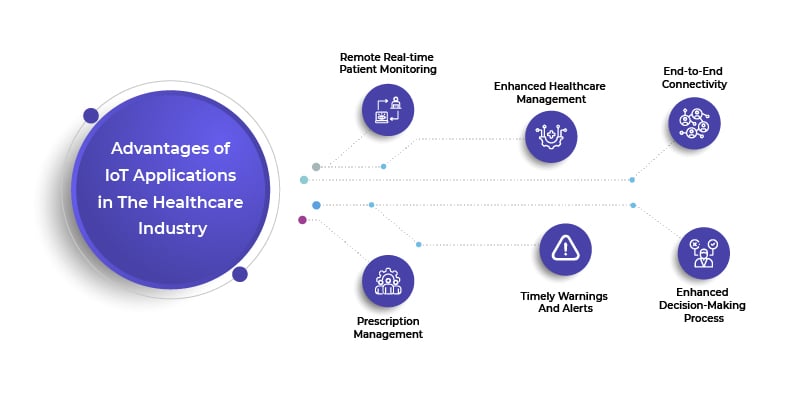
The above-mentioned things have already proved the importance of IoT in the Healthcare industry. Nevertheless, the most important advantage the IoT is bringing to the Healthcare industry is the accuracy of treatment. Medical professionals can figure out the consequences of medical conditions and treatments by acquiring the data accumulated by IoT Healthcare tools for profoundly reliable, permitting knowledgeable judgments. Healthcare departments, practitioners, and proficients can minimize the chances of misunderstandings through the wide usage of the IoT that helps them with patient learning. The data can be estimated immediately and transferred to a committee of doctors or a Healthcare cloud program effortlessly. AI-driven algorithms operating on specific IoT devices could further help make comprehensible conclusions or recommendations based on existing data.
1) Enhanced Healthcare Management
Added prominent advantage of IoT in Healthcare is lessened expenses. With IoT in Healthcare, non-critical patients will be capable of staying at home. At the same time, multiple IoT tools observe and transfer all vital messages to the health department - indicating fewer hospital stays and doctor appointments. With comprehensive data collected from quantities of IoT devices, health facilities will also be capable of improving their illness management. They will have more comprehensive data in real-time, growing in size than ever before.
2) Remote Real-time Patient Monitoring
A study shows a 50% reduction in the readmission rate of patients due to remote supervision. Real-time guidance through IoT devices can protect lives during medical emergencies such as asthma seizures, heart failures, etc. Each connected medical device can accumulate vital data on a patient’s health and transfer it to the doctor in real-time, which can help them enhance their counseling and understand the condition of the patient more accurately.
3) End-to-End Connectivity
Diversified connectivity protocols in the tools enable hospital employees to spot initial symptoms of illness in the patients. IoT can automate the workflow of patient responsibility with the guidance of healthcare mobility solutions. It facilitates interoperability, machine-to-machine interaction, information movement, and knowledge exchange while advancing healthcare delivery more prolifically.
4) Enhanced Decision-Making Process
The data-driven insights will advance the decision-making method of the doctors. IoT appliances can receive, report, and interpret the vast data collected promptly, making the need for its storage. This will help the Healthcare professionals with decision making focusing on relevant data required to treat the patient.
5) Timely Warnings And Alerts
IoT empowers medical devices to accumulate crucial data and transfer it to doctors. The summaries provide a perfect evaluation of the patient’s health, irrespective of location or time. Timely warnings can be essential in case of life-threatening conditions.
6) Prescription Management
The existence of smart wireless pill bottles has made it possible and easier to keep track of medication schedules. This technology helps people to take their pills on time, keep track of their medicine stocks, send reminders to reorder their pills, and also optimize their timely appointments. It can also keep the concerned person informed about the medicine doses, along with offering enhanced analytics to the health professionals advancing more high-grade care to the patients.
Other than IoT, various other technologies are playing an important role in the development and enhancement of the Healthcare Industry in the year 2025.
Technological Trends In The Healthcare Industry
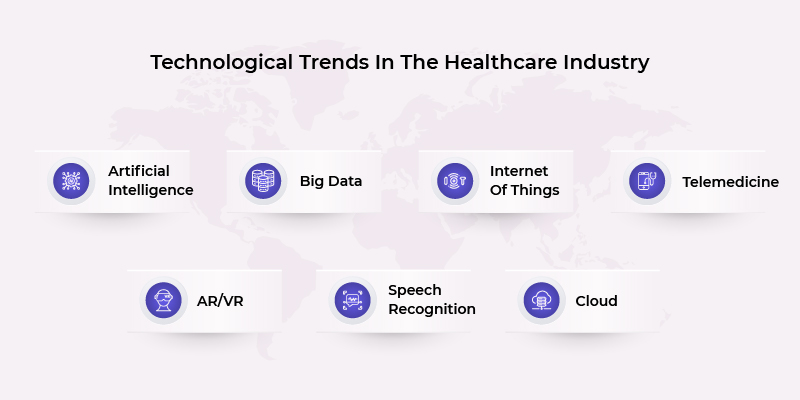
Artificial Intelligence
AI is transforming our outlook on modern-day Healthcare delivery. The technology's potential to change the industry has placed it on the list as one of the prominent technology trends in Healthcare in 2025.
The usage of AI in the global Healthcare industry is going to cross USD 45.2 billion by 2026 from USD 4.9 billion in 2020. The fact that AI is bringing various innovations in the Healthcare industry is putting a full stop to the decision of whether AI is bringing the changes or not but focusing on the other one about how we can implement AI in the Healthcare system.
It depicts a set of several technologies that enable machines to comprehend, sense, learn, and act like humans to the extent that they are prepared to perform many clinical and administrative Healthcare functions.
AI is fueling the capacity to create more precise predictions about patient care and results. The augmented demand for remote medical care for routine checkups and non-pandemic care is driving the force of digital visits and remote patient care.
Along with that, the real-time location system (RTLS) or location technicalities based on AI providing its benefits to identify and track the status of an object are used within the Healthcare network. It also follows the treatment process based on the allocation of available resources.
One of the most extensively used technologies is the Global Positioning System, commonly known as GPS. It makes use of satellites for tracking purposes. We can identify an object through GPS as long as there is a clear sightline between the thing and four various satellites. We can enhance the Healthcare system by employing IoT trackers that can discover the position of the ambulance, Healthcare provider, caregivers, patients, etc., in real-time.
Big Data
While already employed to a considerable extent in the EHR domain, many Healthcare domains will profit highly from Big Data in 2025 and beyond, causing Big Data tech to be the most viewed technology.
To list down below are the Healthcare fields that will get benefited from the incorporation of Big Data in the industry;
-
It will remove medication mistakes.
-
It will help to lower wait time and hospital costs.
-
It improves the quality of service.
-
It gives greater security.
-
It prevents preventive and over-reactive care.
-
It provides more definitive personalized treatment and medicine.
Internet Of Things
There are many motives why the Healthcare industry needs IoT advancement in the industry. Reasons range from turning data into action, improving patient health, promoting preventive care, enhancing patient engagement and satisfaction, and advancing care management.
IoT applications have previously been seeing a lot of attention from the Healthcare domain. There are many viable samples of how Healthcare is getting better with IoT; here are a few of them;
-
Closed-Loop Insulin Delivery
-
Movement Trackers
-
United Inhalers
-
Ingestible Sensors
-
United Lens
Telemedicine
As telehealth advances, the facility is known to overcome the overall cost incurred by the hospital structure. The Healthcare system will see many new entrants in the economy. The implementation of this tech in Healthcare will aim to provide real-time patient care and accurate diagnosis before a medical emergency occurs.
AR/VR
Technology and Healthcare have developed considerably, and one of the most prominent contributing roles in Healthcare mobile app trends is augmented reality and Virtual Reality development services. The healthcare-based AR and VR business is poised to become a $5.1 Billion market by the time it reaches 2025. While the time is still too notably off, the importance of AR/VR in the Healthcare domain is already seen in multiple arenas.
The result that AR/VR has shown in Healthcare and the potential that it carries together makes Healthcare the most extensive use case of the AR/VR industry.
On the one hand, technology helps doctors make more precise surgeries; the patients, on the other hand, profit from the virtual reality scenes that help them succeed in trauma with greater ease while being in a safe environment.
Both reasons collectively make AR/VR one of the most critical trends in
Healthcare app development. AR/VR is known to improve upon all four main Healthcare areas - Diagnostic, Training, Treatment, and Rehabilitation.
Speech Recognition
Speech Recognition has a place in many healthcare fields. From helping the end user find the right doctor in their proximity to assisting the doctors in surgery by giving them a step-by-step checklist of the whole procedure, voice technology-based tools like Alexa and Google Homes have found a place in many hospitals and clinics.
While Speech Recognition is transforming how patients and doctors both respond to medicine, on the one hand, on the other, the voice-based search is improving how individual doctors and hospitals are vending their services in the world.
Cloud
While cloud computing had moved beyond the Enterprise world in yesteryears, the collision required to have on the Healthcare Industry is still relatively new and yet huge. There are many ways through which cloud technology is known to avail Healthcare. Here is how Cloud is poised to revolutionize the Healthcare economy:
As Software Service – Cloud can render the Healthcare organization a range of on-demand hosted services that would furnish them with fast access to business applications.
Platform as a Service – The cloud can give a security-enhanced environment for web-based service and cloud application deployment.
Infrastructure as a Service – Cloud solutions can provide on-demand computing and storage for a medical facility.
Along with IoT, Mobile health applications are also playing an important role in enhancing the offering of the Healthcare system.
Advantages Of Mobile Health Apps Lessened Risk Of Errors
Medical professionals require access to many kinds of clinical sources to make precise diagnostic judgments. With the aid of mobile health apps, doctors and nurses can access medical data, lab results, etc., in a short span of time. They furthermore can utilize smartphones and apps for drug reference guides, clinical rules, and other decision-support aids. Informed medical choices take down the error rate and improve practice productivity and information. On the patient's side, they can get an early warning to discover complications and plan their treatment correctly.
Streamlining Clinical Methods
As per the research, the IoT Healthcare business will reach $188.2 billion by 2025; it is evident that medical specialists are putting supplies into innovative Healthcare apps and Healthcare app ideas to bring extensive change in the industry. Moreover, the IoT alliance with Healthcare has given an approach to maintaining resources. The medical staff can also keep a check on their outstanding stocks effectively and systematically preserve them.
A Healthy Lifestyle
As more individuals become conscious about maintaining a sound and healthy lifestyle, innovative Healthcare apps are the most famous health applications. With cutting-edge and high-level digital accessories, smartwatches, health apps, and fitness trackers are intended to empower individuals to remain fit, eat healthily, and improve their sleep cycle. These health apps allow users to follow their weight, food intake, pulse, heart rate, calorie consumption, and other personal information. Users who utilize these applications can share this information with their fitness coaches or associates to get more guidance and support.
Hurdles And Solutions
It shouldn't appear as astonishment that cost is the biggest hurdle when businesses attempt to implement an IoT approach, but simply declaring, "It's too expensive", and doing nothing is no longer an alternative. The recommendation is that the organizations begin small, learn quickly, and grow out with remarkably quick successes.
Everyone has to monitor hazardous circumstances, so why don't you start in the built space environment? Perhaps talk about monitoring devices or things that are extremely obvious and straightforward to implement and explain that they would be successful.
Winding Up
So above-mentioned was some information and trends that will define the Healthcare market in 2025 and beyond. We hope to perform at the back of these upcoming trends in a Healthcare economy that is more prudent than reactive and more human-focused than revenue-focused.
Since it is an advanced digital era, you can also opt for expert agencies without thinking much about the distance. For example, suppose you stay in the European region. In that case, you can look for a healthcare app development company in the USA or a
healthcare mobile app development firm in other states.
IoT in the healthcare industry does not survive alone. All IoT tools and their systems need to be merged with different technologies to improve healthcare facilities' transformation significantly. As discussed before, IoT will reform the healthcare industry, although it also requires data, high-speed connection, and conventional safety and acquiescence.
5G will implement the ultra-low latency activities and versatility that the IoT in the healthcare industry demands. In turn, AI-driven resolutions will secure a sense of the data ponds assembled from various methods. Big Data will apply such AI algorithms to interpret data in real-time and gain significant health judgments. Virtualization will benefit from reducing or getting relieved of old infrastructure in hospitals.
IoT is already practicing most of these technologies to assist healthcare in development, and this development will proceed. Promptly than later, healthcare and the Internet of Things will become intertwined, ultimately modifying how we approach our healthcare.
We at Hyperlink InfoSystem, grant businesses and their healthcare workforce with cutting-edge transformative clarifications and data-driven penetrations.
With advancements in technology occurring every day, the opportunities for enhancing care, operational efficiencies, and patient well-being through IoT are everlasting. IoT is the future, so start to develop and implement your IoT strategy now.
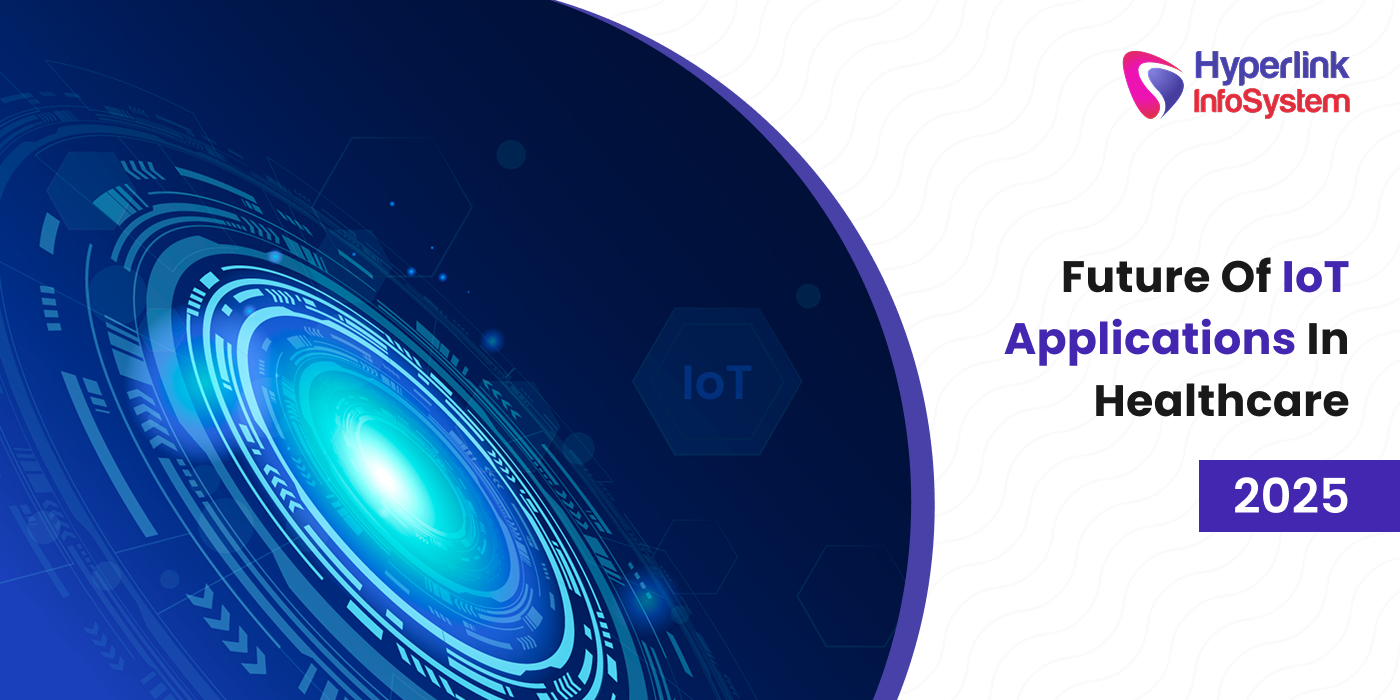
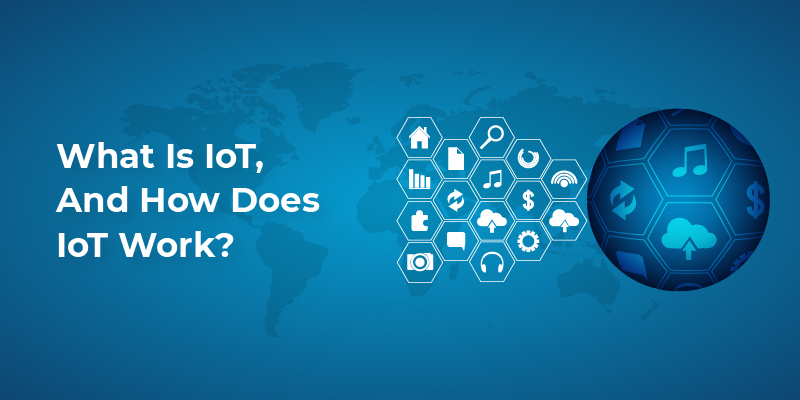

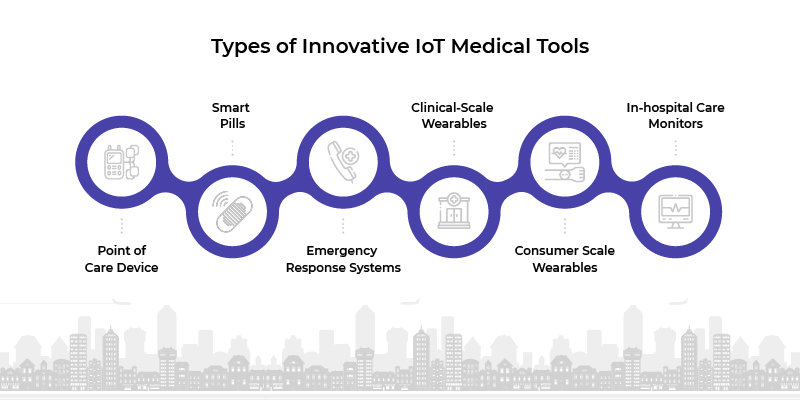




















 Next
Next

